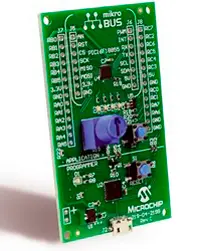Electronics News
Archive : 16 February 2016 год
 In a move targeted at developers not familiar with the PIC microcontroller, Microchip has launched MPLAB Xpress, a Cloud based integrated development environment (IDE) which it claims is the easiest way to get started with PIC MCUs.
In a move targeted at developers not familiar with the PIC microcontroller, Microchip has launched MPLAB Xpress, a Cloud based integrated development environment (IDE) which it claims is the easiest way to get started with PIC MCUs.
The free IDE is said to provide access to popular features from the company’s MPLAB X IDE, including a library of validated code examples and an interface to MPLAB Code Configurator (MCC) 3.0 for GUI-based MCU peripheral setup and automatic code generation. Users will also have access the XC compiler and to 10Gbyte of secure online storage when they sign up for a myMicrochip account.
Greg Robinson, director of 8bit MCU marketing, said: “It’s the easiest way to get started with PIC MCUs. We are working on adding code examples to the environment and we will be validating them so we know they work and do everything they are supposed to.”
According to Robinson, users can go to the web, access and edit code, compile it and then download to the Xpress evaluation board, pictured. Available for less than $10, the board features an integrated programmer, a PIC16F18855 MCU and a mikroBUS header that allows users to access more than 180 Click boards. MPLAB Xpress IDE also supports Microchip’s Curiosity development board and the PICkit 3 in circuit debugger/programmer.
Although the initial roll out only supports the 8bit XC compiler, the company is planning to extend support to its 16 and 32bit parts later in 2016.
Meanwhile, Microchip is urging developers to join the MPLAB Xpress community. “Users will be able to share, search, discuss and learn,” said Robinson. “It will be a big piece of the puzzle.”
An examples section will include searchable access to MCU code developed and validated by Microchip engineers, while designers can make any of their stored projects available to other community members.
Pic: Microchip's Xpress evaluation board
Author
Graham Pitcher
Source: www.newelectronics.co.uk
 Researchers from University College London (UCL) have designed and tested technology that could reduce the cost of deploying fast fibre connections straight to homes. It is claimed that the technology will help address the challenges of providing households with high bandwidths while future-proofing infrastructure against the growing demand for data.
Researchers from University College London (UCL) have designed and tested technology that could reduce the cost of deploying fast fibre connections straight to homes. It is claimed that the technology will help address the challenges of providing households with high bandwidths while future-proofing infrastructure against the growing demand for data.
While advances have been made in core optical fibre networks, they often terminate in cabinets far from the end consumers. The so called 'last mile' which connects households to the global Internet via the cabinet, is still almost exclusively built with copper cables as the optical receiver needed to read fibre-optic signals is too expensive to have in every home.
Lead researcher, Dr Sezer Erkilinc, said: "We have designed a simplified optical receiver that could be mass-produced cheaply while maintaining the quality of the optical signal. The average data transmission rates of copper cables connecting homes today are about 300Mbit/s and will soon become a bottleneck in keeping up with data demands, which will likely reach about 5 to 10Gbit/s by 2025. Our technology can support speeds up to 10Gbit/s."
The scientists say they have developed a way to solve the 'last mile problem' with fibre-to-the-home (FTTH) broadband technology. They claim to have improved the sensitivity and network reach of the optical receiver compared to existing technology. Once commercialised, it will lower the cost of installing and maintaining active components between the central cabinet and homes.
A major factor limiting the uptake of FTTH is the overall cost associated with laying optical fibre cables to each household and providing affordable optical receivers to connect them to the network. The sensitive coherent optical receivers used in core networks are desirable but are also complex, which makes them expensive to manufacture. Using such receivers in homes increases the cost of FTTH beyond the current copper based solutions.
The UCL optical receiver is said to retain many of the advantages of the ones typically used in core networks, but is smaller and contains around 75 to 80% fewer components, lowering the cost of manufacture and maintenance.
Co-author, Dr Seb Savory, explained: "We achieved this by applying a combination of two techniques. First a coding technique often used in wireless communications was used to enable the receiver to be insensitive to the polarisation of the incoming signals. Second we deliberately offset the receiver laser from the transmitter laser with the additional benefit that this allows the same single optical fibre to be used for both upstream and downstream data."
The researchers are now investigating the laser stability of the receiver, which is an important step to building a commercial prototype of the system.
Author
Tom Austin-Morgan
Source: www.newelectronics.co.uk

